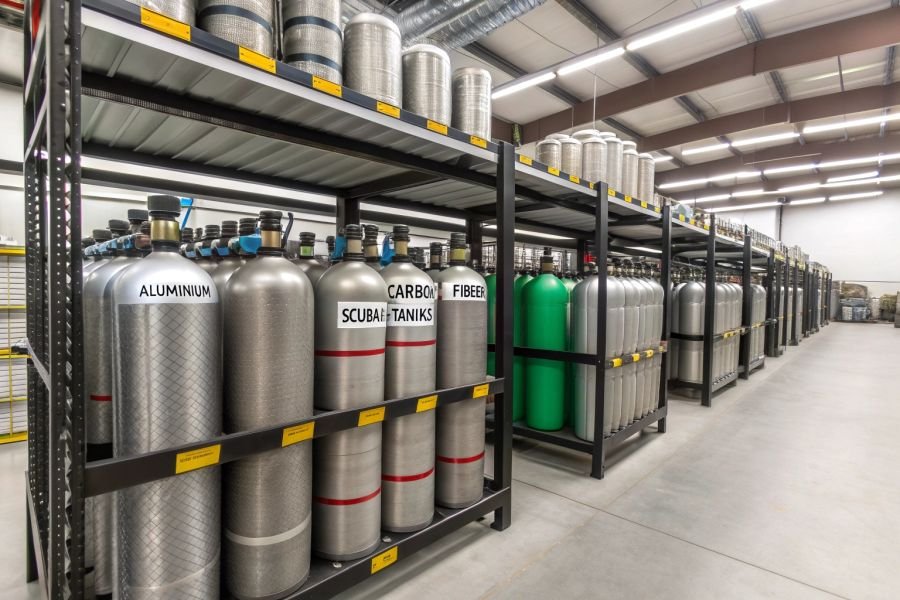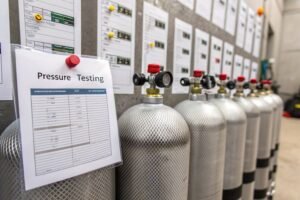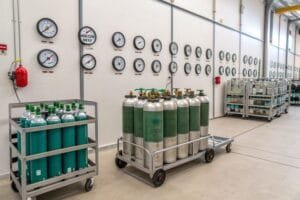A cracked gas tank puts you and your equipment at serious risk. You need the right fix fast. But can aluminum tape actually solve this dangerous problem?
No, you should never use aluminum tape to fix a cracked gas tank. Aluminum tape cannot withstand the high pressure and chemical properties of compressed gases, making it unsafe and ineffective for gas tank repairs.
I've been manufacturing gas cylinders for over a decade at our factory in China. I've seen too many dangerous situations caused by improper repairs. Let me share what really works and what puts lives at risk.
How to seal a crack in a gas tank?
A cracked gas tank is not a DIY repair job. You're dealing with high pressure systems that can cause serious injury or death if handled wrong.
The only safe way to seal a crack in a gas tank is through professional welding repair or complete cylinder replacement. Temporary fixes like tape or sealants are dangerous and violate safety standards.
Professional repair requires specific steps. First, the cylinder must be completely evacuated and purged of all gases. This prevents explosions during welding. The crack area needs thorough cleaning to remove any contaminants.
A certified welder then uses the proper welding technique based on the cylinder material. For aluminum cylinders, TIG welding works best. Steel cylinders typically need MIG or stick welding. The weld must penetrate completely through the crack.
After welding, the cylinder goes through pressure testing. We test at 1.5 times the working pressure to ensure safety. The cylinder also needs visual inspection for any defects. Only certified repair facilities should handle this work.
| Repair Step | Aluminum Cylinders | Steel Cylinders |
|---|---|---|
| Preparation | Complete evacuation and purging | Complete evacuation and purging |
| Welding Method | TIG welding | MIG or stick welding |
| Test Pressure | 1.5x working pressure | 1.5x working pressure |
| Certification | Required by law | Required by law |
Many customers like David from Australia ask me about quick fixes. I always tell them the same thing. Your life is worth more than the cost of proper repair or replacement.
Is aluminum tape gas resistant?
Aluminum tape might look strong, but it fails quickly under gas cylinder conditions. The adhesive breaks down and the tape itself cannot handle the pressure.
Aluminum tape is not gas resistant and will fail under the high pressure and chemical exposure found in gas cylinders. The adhesive degrades rapidly when exposed to compressed gases.
Gas cylinders operate at pressures up to 300 bar or 4350 PSI. Aluminum tape is designed for HVAC ductwork at near-zero pressure. The pressure difference is enormous. Even small leaks create jet forces that tear tape apart.
The chemicals in compressed gases attack the adhesive. Oxygen makes adhesives break down faster. Hydrogen can actually pass through most materials at the molecular level. Carbon dioxide creates acidic conditions that eat away at tape.
Temperature changes make the problem worse. Gas expansion during filling heats the cylinder. Rapid gas release cools it down. This thermal cycling makes tape lose adhesion quickly.
I've tested aluminum tape on sample cylinders at our factory. The tape fails within hours under normal operating pressure. At higher pressures, it fails in minutes. This is why professional repair is the only safe option.
Can flex seal be used on gas tanks?
Flex seal products are popular for many repairs, but gas tanks are not one of them. These products are not designed for high pressure gas applications.
Flex seal should never be used on gas tanks because it cannot withstand high pressures and may react dangerously with compressed gases. It also violates safety regulations for pressure vessels.
Flex seal works by forming a rubber coating over surfaces. This coating might stop water leaks at low pressure. But gas cylinders operate at pressures that would blow through flex seal like tissue paper.
The rubber compounds in flex seal are not compatible with all gases. Some gases cause the rubber to swell or dissolve. Others make it brittle and crack. Oxygen accelerates the breakdown of rubber compounds.
Safety regulations specifically prohibit using flexible sealants on pressure vessels. These regulations exist because people have been seriously injured or killed by improper repairs. Insurance companies also refuse coverage for equipment repaired with non-approved methods.
Juan, one of my customers from the USA who works with hydrogen systems, once asked about using flex seal. I explained that hydrogen gas is so small it passes through most materials. No flexible sealant can contain it safely.
| Sealant Type | Maximum Pressure | Gas Compatibility | Regulatory Approval |
|---|---|---|---|
| Flex Seal | <15 PSI | Poor | Not approved |
| Aluminum Tape | <30 PSI | Very poor | Not approved |
| Professional Weld | Full cylinder rating | Excellent | Required |
What can seal a gas tank?
Only approved repair methods can safely seal a gas tank. These methods meet strict safety standards and regulatory requirements.
Professional welding repair by certified technicians is the only approved method to seal a gas tank crack. Complete cylinder replacement is often the safer and more cost-effective option.
Welding repair must follow specific procedures. The welder needs certification for pressure vessel work. The repair facility must have proper equipment and testing capabilities. All repairs require documentation and re-certification.
Complete replacement often makes more sense. New cylinders come with fresh certifications and full warranties. The cost difference between repair and replacement is often small. Replacement eliminates any doubt about safety.
Some minor surface scratches can be polished out without welding. But this only works for very shallow marks that don't go through the wall thickness. A certified inspector must evaluate each case.
Composite overwrap repair is possible for some carbon fiber cylinders. This involves adding new layers of carbon fiber over the damaged area. Only specialized facilities can do this work properly.
At our factory, we help customers evaluate repair versus replacement options. We provide detailed cost analysis and safety recommendations. Our goal is keeping everyone safe while minimizing costs.
| Repair Option | Best For | Cost Range | Safety Level |
|---|---|---|---|
| Professional Weld | Small cracks in thick walls | Medium | High when done properly |
| Complete Replacement | All crack types | Varies | Highest |
| Composite Overwrap | Carbon fiber surface damage | High | High when done properly |
Regular inspection prevents most crack problems. Visual checks before each use catch issues early. Professional hydrostatic testing every few years finds hidden problems. Proper storage and handling prevent damage.
Never ignore cylinder damage or attempt unauthorized repairs. The risks are too high. Professional repair or replacement is always the right choice for your safety and legal compliance.
Conclusion
Aluminum tape and other temporary fixes cannot safely repair cracked gas tanks. Only professional welding or complete replacement ensures your safety and meets regulatory requirements.







